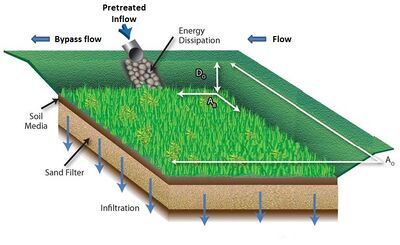
Difference between revisions of "Stormwater infiltration"
m |
m |
||
| Line 57: | Line 57: | ||
*[[References for stormwater infiltration]] | *[[References for stormwater infiltration]] | ||
*[[Supporting material for infiltration]] | *[[Supporting material for infiltration]] | ||
| + | |||
| + | [[Category:Level 2 - Technical and specific topic information/infiltration]] | ||
Latest revision as of 03:39, 13 February 2023

Schematic showing an infiltration basin, which is one of several stormwater control practices designed to infiltrate stormwater runoff. Infiltration practices capture stormwater runoff and allow it to infiltrate into the underlying soil. Pollutant removal occurs through a variety of mechanisms, including adsorption, absorption, plant uptake, and degradation. Note that inflow into the practice has undergone pretreatment and that once the practice is filled, runoff bypasses the practice rather than entering it.
Green Infrastructure: Infiltration of stormwater, where appropriate, is a preferred practice for managing stormwater runoff, as it reduces pollutants reaching receiving waters and retains water on the landscape
This page contains links to several pages that address infiltration of stormwater runoff. Link to portal for Infiltration Practices.
- Overview
- Best Management Practices (BMPs)
- Water quality
- Water quantity
- Separation distances
- Constraints
- When infiltration is not authorized under a stormwater permit
- Karst
- Shallow soils and shallow depth to bedrock
- Shallow groundwater
- Soils with low infiltration capacity
- Potential stormwater hotspots
- Wellhead protection
- Contaminated soils and groundwater
- Procedures for investigating sites with potential constraints
- Guidance for amending soils with rapid or high infiltration rates
- Decision tools
- Determining soil infiltration
- Information on soil
- General information, reference, tables, images, and archives/Tables/Soil and soil properties
- Chloride and groundwater
- Impacts of stormwater infiltration on chloride in Minnesota groundwater - White paper produced for the Minnesota Groundwater Association
- Calculator for estimating chloride loading to groundwater
- Guidance for calculator to estimate chloride loading to groundwater from infiltration
- References for stormwater infiltration
- Supporting material for infiltration
This page was last edited on 13 February 2023, at 03:39.
